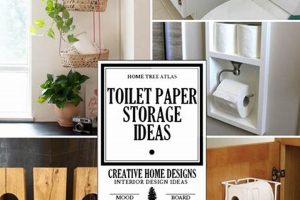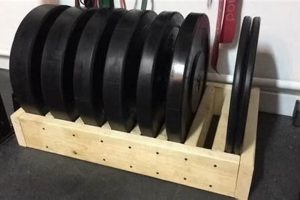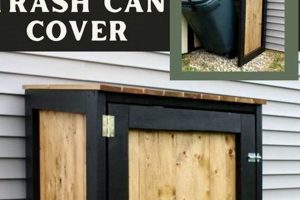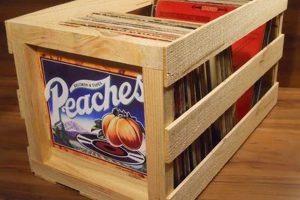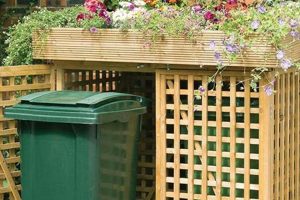Creating shelving units or storage solutions positioned above the toilet is a popular method for maximizing space in bathrooms, especially those with limited square footage. These structures provide supplementary storage for toiletries, towels, and other bathroom essentials. A typical example includes a freestanding unit with open shelves designed to fit over a standard toilet.
The implementation of vertical storage in bathrooms offers several advantages, including improved organization, decluttering, and enhanced accessibility to frequently used items. This approach to space optimization has gained traction due to increasing urbanization and the corresponding reduction in living space sizes. It represents an efficient and cost-effective method for enhancing functionality without significant renovation.
The subsequent sections will address different approaches to constructing these storage solutions, including material selection, design considerations, assembly techniques, and safety precautions. Various project types, ranging from simple shelving to more complex cabinet structures, will be explored to offer a range of options.
Tips for Successful Over Toilet Storage Construction
The following guidelines are intended to enhance the outcome of constructing storage solutions designed to fit over toilets, ensuring structural integrity, aesthetic appeal, and functional utility.
Tip 1: Accurate Measurement is Crucial: Prior to commencing construction, meticulously measure the available space above the toilet, including height, width, and depth. Account for plumbing fixtures and any potential obstructions that may impede installation. Precise measurements are fundamental to a secure and properly fitting structure.
Tip 2: Material Selection Based on Environment: Given the humid environment characteristic of bathrooms, opt for materials resistant to moisture. Treated wood, PVC, or metal are viable options. Select finishes and sealants specifically formulated for bathroom applications to prevent water damage and extend the lifespan of the storage unit.
Tip 3: Prioritize Stability and Safety: Construct a robust frame capable of supporting the intended weight. Utilize appropriate fasteners and joinery techniques. Secure the structure to the wall using anchors suitable for the wall type to prevent tipping or collapse, especially in households with children or pets.
Tip 4: Optimize Vertical Space: Design shelves or compartments that maximize the available vertical space. Consider adjustable shelves to accommodate items of varying heights. Integrate storage solutions such as baskets or containers to further organize smaller items and prevent clutter.
Tip 5: Design for Accessibility: Ensure ease of access to stored items. Position shelves at comfortable reach and avoid excessively deep shelves that can obscure contents. Consider incorporating features such as pull-out drawers or doors to facilitate access and maintain a clean appearance.
Tip 6: Consider Aesthetic Integration: Design the storage unit to complement the existing bathroom decor. Select colors, finishes, and hardware that align with the overall aesthetic. A cohesive design will enhance the visual appeal of the bathroom and create a more harmonious environment.
Tip 7: Proper Ventilation Considerations: Ensure the design does not impede airflow, especially if the toilet area is prone to moisture buildup. Consider adding ventilation holes or opting for open shelving to promote air circulation and prevent mold or mildew growth.
Effective implementation of these tips will contribute to the creation of a durable, functional, and aesthetically pleasing over-toilet storage solution, thereby optimizing bathroom space and enhancing overall organization.
The subsequent section will provide a detailed examination of specific project examples and construction methodologies.
1. Measurements Precision
Accuracy in measurement is a non-negotiable prerequisite for successful creation and installation of storage units designed for placement above toilets. The restricted and often uniquely shaped space surrounding a toilet necessitates meticulous attention to dimensional detail to ensure proper fit and function.
- Height Clearance Assessment
The vertical distance between the floor and the underside of the lowest obstruction (e.g., ceiling, light fixture, or pipe) must be accurately determined. Failure to account for adequate headroom can result in an unusable or inaccessible storage unit. An insufficient height allowance prevents effective utilization of the created space, defeating the purpose of the project.
- Width Constraint Evaluation
The horizontal space between surrounding walls or other fixtures dictates the maximum permissible width of the storage unit. Incorrect width measurements can result in a unit that either does not fit or requires forced installation, potentially damaging walls or the toilet itself. Precise width assessment optimizes space utilization without compromising structural integrity.
- Depth Limitation Consideration
The distance from the wall behind the toilet to the front edge of the toilet bowl dictates the allowable depth of the unit. Exceeding this depth may impede access to the toilet or create an obstruction in the bathroom. Thoughtful depth consideration balances storage capacity with user comfort and accessibility.
- Plumbing Fixture Accommodation
The location and dimensions of existing plumbing fixtures (e.g., water supply lines, shut-off valves, or drainage pipes) must be precisely recorded. These fixtures often necessitate cutouts or modifications to the storage unit design. Ignoring these details can lead to installation difficulties or damage to the plumbing system.
These considerations underscore the fundamental role of dimensional accuracy in crafting storage solutions for installation over toilets. The interdependency of these factors necessitates a comprehensive understanding of spatial constraints and fixture locations to create a functional and aesthetically pleasing result. Deviation from precise measurements introduces the risk of project failure or compromised utility.
2. Material Durability
The selection of materials possessing inherent durability is intrinsically linked to the long-term utility and structural integrity of any storage unit designed for placement above a toilet. The bathroom environment presents a unique set of challenges, primarily attributable to elevated humidity levels and potential exposure to water. Consequently, materials lacking resistance to moisture degradation are fundamentally unsuitable for such applications. The direct correlation between material durability and the lifespan of storage solutions is a crucial consideration during the design and planning stages. For example, untreated wood, if utilized in this context, will inevitably warp, swell, and foster the growth of mold or mildew, ultimately compromising the unit’s structural stability and aesthetic appeal.
The implementation of moisture-resistant materials, such as treated lumber, PVC composites, or powder-coated metals, mitigates the risks associated with bathroom humidity. These materials exhibit significantly reduced susceptibility to water damage, thereby extending the functional lifespan of the storage unit. Furthermore, the selection of durable finishes and sealants plays a critical role in protecting the underlying material from moisture penetration. An example of a practical application is the utilization of marine-grade plywood, known for its exceptional water resistance, in the construction of over-toilet storage units designed for use in frequently humid environments.
In summary, the selection of durable materials is a fundamental prerequisite for the successful execution of storage projects intended for placement above toilets. The longevity, structural integrity, and aesthetic appeal of these units are directly contingent upon the ability of the chosen materials to withstand the inherent environmental challenges of the bathroom. Therefore, a comprehensive understanding of material properties and their resistance to moisture degradation is essential for ensuring a functional and enduring storage solution.
3. Structural Stability
Structural stability is a paramount consideration in the design and construction of storage units intended for placement above toilets. Given the elevated position and potential weight-bearing requirements, the inherent stability of these structures directly impacts user safety and the longevity of the unit itself.
- Load-Bearing Capacity
The capacity of the storage unit to support a specified weight is a critical factor in ensuring structural integrity. Over-toilet storage solutions are often utilized to store towels, toiletries, and other bathroom necessities. Insufficient load-bearing capacity can lead to structural failure, resulting in damage to the unit and potential injury to users. For example, shelves constructed from thin or unsupported materials are prone to sagging or collapse under sustained weight. Proper reinforcement and material selection are essential for maintaining a safe load-bearing threshold.
- Joint Integrity
The strength and durability of the joints connecting various components of the storage unit are vital for overall stability. Weak or poorly constructed joints can compromise the structural integrity of the entire unit, particularly under stress. Techniques such as mortise and tenon, dovetail joints, or the utilization of high-quality fasteners contribute to robust joint integrity. For instance, a unit constructed with solely glued joints may exhibit instability and susceptibility to failure under prolonged use or exposure to moisture.
- Anchoring Systems
The method by which the storage unit is secured to the wall is a critical determinant of its overall stability, particularly in preventing tipping or accidental displacement. Inadequate anchoring systems can pose a significant safety hazard, especially in households with children or pets. Utilizing appropriate wall anchors designed for the specific wall type (e.g., drywall, plaster, or concrete) is essential. Furthermore, the number and placement of anchors should be determined based on the size and weight of the unit. Improper anchoring can result in the unit detaching from the wall, causing damage or injury.
- Material Rigidity
The inherent rigidity of the materials used in construction directly influences the overall stability of the over-toilet storage unit. Materials lacking sufficient rigidity are prone to warping, bending, or deflection under load, thereby compromising structural integrity. Selecting materials with high stiffness and resistance to deformation, such as solid wood or reinforced composites, is crucial for maintaining a stable and secure structure. A unit constructed from flexible materials may exhibit instability and an increased risk of collapse.
The interplay of load-bearing capacity, joint integrity, anchoring systems, and material rigidity collectively defines the structural stability of over-toilet storage solutions. Adherence to sound engineering principles and meticulous attention to detail during the design and construction phases are paramount for ensuring a safe, durable, and functional addition to any bathroom. Overlooking any of these elements can significantly compromise the unit’s integrity, posing safety risks and reducing its lifespan.
4. Design Functionality
Design functionality, in the context of storage solutions for placement above toilets, embodies the synthesis of form and purpose. It dictates how effectively a structure fulfills its intended role of providing accessible and organized storage within the often-confined spatial parameters of a bathroom. Inefficient or poorly conceived designs directly undermine the utility of vertical storage, thereby negating the core benefits of such projects. The success of any endeavor aimed at creating this type of storage hinges on a meticulous consideration of the intended user’s needs, the available space, and the specific items to be stored.
A structure designed without sufficient shelf height to accommodate commonly used items like shampoo bottles, or one positioned in a way that obstructs access to the toilet paper dispenser, exemplifies a failure in functional design. Conversely, a well-designed unit incorporates adjustable shelving to accommodate items of varying sizes, integrates strategically placed towel bars for convenient access, and incorporates enclosed compartments to conceal less aesthetically pleasing items. The inclusion of features such as pull-out drawers or integrated lighting can significantly enhance usability and overall user satisfaction. Careful attention to the ergonomic aspects of the design, such as shelf depth and door swing direction, further optimizes functionality and minimizes potential inconveniences.
Ultimately, the design functionality of storage units created to fit above toilets is not merely an aesthetic consideration but a critical determinant of the structure’s practical value and long-term utility. Addressing this element thoughtfully ensures that the created space serves its intended purpose of enhancing organization and accessibility, thereby contributing to a more efficient and enjoyable bathroom experience. Neglecting this aspect yields a visually appealing but functionally deficient addition, negating the potential benefits of utilizing vertical space for storage.
5. Aesthetic Integration
Aesthetic integration, in the context of creating storage solutions designed for placement above toilets, represents a critical dimension beyond mere functionality. It encompasses the harmonious alignment of the storage unit’s visual characteristics with the existing design elements of the bathroom, thereby contributing to a cohesive and visually pleasing environment.
- Color Palette Harmony
The selection of colors that complement or subtly contrast with the existing bathroom color scheme is fundamental. Storage units finished in hues that clash jarringly with the surrounding walls, fixtures, or accessories disrupt visual harmony. Conversely, a unit painted in a complementary shade can enhance the overall aesthetic appeal, creating a unified and balanced appearance. An example of this would be using the existing accent color for the hardware pulls, creating a coordinated design element.
- Material Consistency
The choice of materials used in the construction of the storage unit should align with the predominant materials already present in the bathroom. Employing dissimilar materials can create visual discord and undermine the sense of cohesion. For instance, installing a storage unit constructed from unfinished pine in a bathroom predominantly featuring chrome and glass elements will likely appear out of place. The selection of materials that echo existing finishes contributes to a seamless and integrated aesthetic.
- Style Compatibility
The design style of the storage unit should correspond with the overall stylistic theme of the bathroom. Installing a contemporary, minimalist unit in a bathroom adorned with traditional or Victorian-era elements can create a jarring juxtaposition. Conversely, a storage unit that mirrors the existing design style, such as a rustic unit in a farmhouse-style bathroom, enhances the overall visual coherence.
- Hardware Coordination
The selection of hardware, such as knobs, pulls, and hinges, plays a subtle yet significant role in aesthetic integration. Hardware that complements the existing fixtures and accessories contributes to a unified and refined appearance. Utilizing brushed nickel hardware on a storage unit in a bathroom featuring chrome fixtures can disrupt the visual harmony. Matching hardware finishes creates a cohesive and well-considered aesthetic.
The successful aesthetic integration of over-toilet storage solutions is not merely an ancillary consideration but a vital component of creating a visually pleasing and harmonious bathroom environment. These factors extend beyond mere visual appeal, contributing to an increased sense of spatial coherence and refined aesthetic value. Addressing these elements thoughtfully elevates the overall design and enhances the user experience.
6. Ventilation Considerations
The implementation of storage solutions above toilets necessitates careful consideration of ventilation, as the enclosed space can exacerbate existing humidity issues common in bathrooms. Inadequate airflow can foster the growth of mold and mildew, potentially compromising both the structural integrity of the storage unit and the air quality within the bathroom. Effective ventilation strategies must be integrated into the design and construction process to mitigate these risks.
- Material Selection and Airflow
The selection of materials used in the construction of storage units influences airflow and moisture retention. Non-porous materials, while resistant to water damage, can trap moisture behind the unit, promoting mold growth. Conversely, using materials that allow for some degree of air circulation, such as slatted wood or wire mesh, can improve ventilation. An example is the use of open shelving rather than solid doors to facilitate air movement and reduce moisture buildup. The composition of the chosen materials directly impacts the ventilation properties of the structure.
- Design Integration of Ventilation Features
The design phase should incorporate specific ventilation features to promote airflow around and behind the storage unit. This can include the integration of ventilation holes, strategically placed gaps, or the use of open-backed designs. For example, adding small vent holes near the top and bottom of an enclosed cabinet can create a convective airflow pattern, reducing moisture accumulation. The presence of such features directly impacts the mitigation of moisture-related issues.
- Clearance and Spacing Considerations
Ensuring adequate clearance between the storage unit and surrounding surfaces is crucial for promoting airflow. A storage unit placed flush against the wall restricts air circulation and can create pockets of stagnant, humid air. Providing a small gap between the unit and the wall, or between the unit and the toilet tank, allows for greater air movement. For example, a one-inch gap can significantly improve airflow and reduce the risk of mold growth. Spatial arrangement is a critical factor in ventilation efficiency.
- Interaction with Existing Ventilation Systems
The storage unit’s design should not impede the functionality of existing bathroom ventilation systems, such as exhaust fans. Obstructing the airflow path of the exhaust fan reduces its effectiveness in removing moisture from the room. Positioning the storage unit in a way that does not block the fan’s intake or exhaust ports is essential. The integration with existing systems is vital for maintaining overall bathroom air quality.
These factors illustrate the direct relationship between ventilation considerations and the design and construction of storage units intended for placement above toilets. By integrating ventilation-promoting features and carefully considering material selection and spatial arrangements, the risks associated with moisture buildup and mold growth can be significantly reduced, ensuring both the longevity of the storage unit and the maintenance of a healthy bathroom environment.
Frequently Asked Questions
This section addresses common inquiries regarding the design, construction, and installation of storage solutions positioned above toilets. The information presented is intended to provide clarity and guidance for individuals undertaking such projects.
Question 1: What are the primary safety considerations when constructing storage designed for placement above toilets?
Structural integrity is paramount. Ensure the unit can support anticipated loads without compromising stability. Securely anchor the unit to the wall using appropriate hardware suitable for the wall type. Avoid materials that splinter or shatter easily, especially at head height. Consideration should be given to potential head impact; rounded edges or soft materials may mitigate injury risk.
Question 2: What materials are most suitable for withstanding the humid environment typically found in bathrooms?
Moisture-resistant materials are essential for longevity and prevention of mold or mildew growth. Treated lumber, PVC composites, and powder-coated metals are viable options. Untreated wood is generally unsuitable due to its susceptibility to water damage. Consideration should be given to the specific humidity levels within the bathroom when selecting materials.
Question 3: How can adequate ventilation be ensured to prevent moisture buildup behind a storage unit?
Incorporate design elements that promote airflow. This can include ventilation holes, strategically placed gaps, or open-backed designs. Adequate clearance between the unit and the wall allows for greater air circulation. Avoid impeding the functionality of existing bathroom ventilation systems, such as exhaust fans. Regular inspection for moisture is advised.
Question 4: What are the key measurements that must be considered before beginning construction?
Accurate measurements of the available space above the toilet are critical. Height clearance, width constraint, and depth limitation must be precisely determined. Account for the location and dimensions of plumbing fixtures. Incorrect measurements can lead to installation difficulties or compromised functionality. Multiple measurements are recommended to ensure accuracy.
Question 5: How can the design of the storage unit be integrated seamlessly with the existing bathroom dcor?
Consider the existing color palette, materials, and style of the bathroom. Select colors, finishes, and hardware that align with the overall aesthetic. Avoid jarring juxtapositions of styles or materials. The storage unit should complement, rather than detract from, the existing design elements. Sample materials may be helpful to decide the overall outlook and impact to the existing environment.
Question 6: What are the most common mistakes to avoid during the construction process?
Failure to accurately measure the available space is a common error. Selecting unsuitable materials, neglecting structural stability, and overlooking ventilation requirements are also frequent mistakes. Rushing the construction process or neglecting safety precautions can lead to unsatisfactory results or potential injury. Plan and execute the project with care and attention to detail.
In summary, successful implementation of over-toilet storage solutions requires careful planning, accurate measurements, appropriate material selection, and diligent attention to safety and ventilation. These considerations are paramount for creating a functional and aesthetically pleasing addition to any bathroom.
The subsequent section provides a detailed examination of specific project examples and construction methodologies.
Conclusion
The preceding analysis has detailed the multifaceted considerations involved in over toilet storage diy, encompassing measurement precision, material durability, structural stability, design functionality, aesthetic integration, and ventilation considerations. Mastery of these elements is crucial for achieving a successful outcome.
The responsible execution of over toilet storage diy projects necessitates a commitment to safety, precision, and thoughtful design. Diligent adherence to established principles ensures not only the longevity of the structure but also the enhancement of bathroom functionality and aesthetics. Further research and careful planning are strongly encouraged prior to initiating any construction effort.


